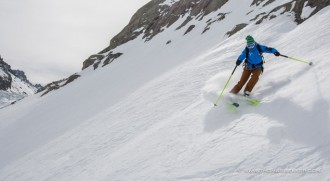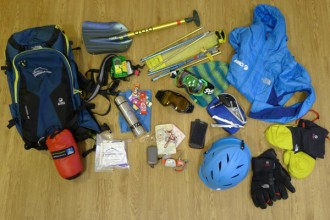Top tips For Back Country Ski Adventures This Winter
Andy Townsend Head of Skiing at Glenmore Lodge has worked as a skiing and mountaineering instructor for many years. Back in the days of his youth he wasn’t quite so well qualified and had a few epic adventures out in the snow! Thankfully he is now one of the senior instructors at Glenmore Lodge and has been sharing his top ten tips for happy and safe backcountry skiing, some of which also apply to touring and those piste skiing who might want to venture a bit further.
If you want more information on those top tips from Andy, visit Ellis Brigham Mountain Sports for the full article.
“It’s a miracle that I managed to graduate from University with a half decent degree. I had a flexible approach to my studies and spent a significant portion of my time climbing and skiing, I was learning lots, but not all academic.
One January I joined a group of friends on a holiday in The Alps. We arrived in the middle of a snow storm. Huge snowflakes fell from the sky and as we moved into our first floor apartment there was already half a metre of snow on the ground. Due to the avalanche risk there were only a couple of lifts working so we set about skiing the buried pistes. Now, our group were quite experienced skiers but we had never skied snow this deep and so began a very steep learning curve.
Over the course of the week we learnt how to ski in the deeper and deeper snow, how to avoid falling and disappearing like a submarine, and how to keep the snow out of every part of clothing. We had experienced avalanches, fallen into holes and skied over the roof of a chair lift station – it was epic and knowing what I do now it’s a miracle that I was able to return to university at all.
Since those halcyon, carefree days of my youth I have gone on to qualify as a mountain guide and have introduced clients to the joys of backcountry skiing throughout Europe and Canada. I still think back to that week in Tignes and still teach some of the lessons from that epic week.
Top tips
Boots
 This might seem obvious, but you would be surprised by how many folks don’t look after their feet and select the wrong boot for them and their chosen activity. Start by having a good look at yourself, how much piste/off piste do you do, are you a ski tourer focused on skinning up or are you going to straight line the Glacier Rond in two turns. Don’t listen to thousands of opinions from everyman and his dog, take the advice of a specialist boot fitter and make your own decision.
This might seem obvious, but you would be surprised by how many folks don’t look after their feet and select the wrong boot for them and their chosen activity. Start by having a good look at yourself, how much piste/off piste do you do, are you a ski tourer focused on skinning up or are you going to straight line the Glacier Rond in two turns. Don’t listen to thousands of opinions from everyman and his dog, take the advice of a specialist boot fitter and make your own decision.
Choose your weapon carefully
It never fails to amaze me how many different types of ski there are, every shape, size and colour. It’s a bewildering array and the only way to cope is to buy a ‘quiver’ of skis, at least 3 sets each! Joking aside, try before you buy is a good place to start. There are lots of ski test events around the UK and in the Alps and these will help make your selection.
Develop an obsession with the weather and avalanche reports
We all have little routines that are fixed in our daily lives, for me it’s looking at the weather forecast and avalanche reports. I do it at night after dinner and in the morning again with my cereal and I do it every day without fail. A cursory glance in the morning as you’re in the lift queue is simply not enough, this is only setting you up nicely for a massive fail.
Learn to ski
Sounds obvious, and if you’re reading this then you can probably already ski, but is your skiing ready for the backcountry? With the rise of modern floaty and rockered skis there is no long and difficult learning curve, you can almost clip into a set of bindings point them downhill and hey presto you’re skiing like Mike Hattrup, Glen Plake or Scott Schimdt, and herein lies the problem!
Work as a team
Never ski in the backcountry alone, this is a well-used and obvious statement, but the one you never hear is never ski with strangers. You need to know your skiing companions, their style, behaviour and skill level. Pick itineraries and conditions that best suit everyone in the group, not just the best skier. Work together to avoid avalanches at all cost, space out, don’t ski at the same time, move from island of safety to island of safety and watch each other at all time like hawks.
Go with a Guide
Without a doubt skiing in the backcountry is dangerous. Hiring a qualified IFMGA mountain guide is a good idea, not only will they help you find the best snow but they will also show you how to manage the risks of backcountry skiing so you can have your own adventures. Clipping into your bindings with a guide is an act of friendship and will certainly be one of the best investments you ever make.
Get a decent rucksack
I have a particular dislike of the tiny handbag-sized rucksacks you see folks skiing with. These packs are so small everything is on the outside and there is no room for all the useful stuff you need to carry. As a rule, if it doesn’t fit inside your rucksack, get a bigger pack!
Here is a picture of the contents of my 30 litre rucksack, which is the bare minimum I would ski off-piste with, for the complete list see the full article at Ellis Brigham Mountain Sports
Do an avalanche course
 An obvious top tip really, but the only one that may save your life. There are lots of courses available, from really techy science-based to practical ones that concentrate on how to ski in the backcountry. It’s worth pointing out that we know more about the surface of the moon than we do about avalanches. We will never be able to accurately predict which slope will avalanche and which won’t.
An obvious top tip really, but the only one that may save your life. There are lots of courses available, from really techy science-based to practical ones that concentrate on how to ski in the backcountry. It’s worth pointing out that we know more about the surface of the moon than we do about avalanches. We will never be able to accurately predict which slope will avalanche and which won’t.
Have a checklist
I have been skiing for quite a long time, and I am still as keen as I was when I started. This excitement has got the better of me and I have forgotten kit and made foolish decisions in my haste to get fresh tracks. Checklists are a brilliant way to remember everything and still be first on the mountain. I have a small laminated card in my rucksack with a list of the contents and also an emergency card with reminders of what to do and who to call in the event of an accident.
Open your eyes
So what is my last top tip? Well, after all the ones about kit, ski technique and avalanche avoidance, the ultimate tip is to simply open your eyes and enjoy the mountains. Skiing in the backcountry is a wonderful experience that enriches your soul and makes you appreciate how amazing the winter landscape really is. It doesn’t matter if you haven’t got this year’s must-have skis or that you can’t do a McConkey turn. What does matter is that you venture into this world and come home with some memories that will stay with you forever.